

|
Back to |
| The Front Page |
| Archives |

|
New Zealand: How did they (almost) do it by Graham Beale Action photos by Jeff Soo; team portraits by Graham Beale Posted April 07, 2000 |
This was a remarkable series, distinguished by the incredibly close test matches in the final round of the competition. Events conspired to produce a fantastic finale culminating in two test matches won by the narrowest of margins, 11-10, with the final match of each test being decided in the third game of a best of three! Not since Keith Wylie defeated Neil Spooner in the deciding match of the 1982 series has the MacRobertson produced such a dramatic culmination to a series.
The MacRobertson Shield series 2000 was one of the most exciting in the history of the event. To have been present during the eighteen days of enthralling - at times nail-biting - competition of the highest level was an honour indeed. The final result is now history. The British secured the spoils of victory for the eleventh time, followed closely by a tenacious New Zealand team; and the United States captured a meritorious third placing for the first time since their inclusion in 1993. This left Australia as the fourth placed team, consigned the now traditional task of performing their national anthem at the closing ceremony.
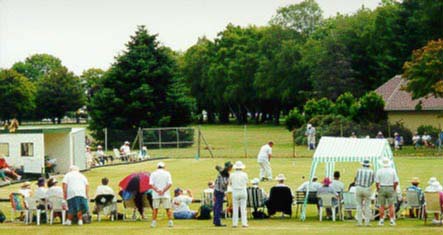
|
| Britain's David Maugham takes the deciding match of the game in high style - with a textbook triple. |

|
| Australians Pickering and Dawson try to figure out what to do next after Pickering derails his test-winning break against the U.S. by cross-wiring himself from his penult pioneer; they found no remedy, losing to Taves and Stark and giving the Americans their third-place breakthrough. |
Final test scores of 20 - 1 in favour of the Brits and 13 - 8 for the Kiwis over the US confirmed for many that defeating the star-studded Great Britain team was going to be nigh on impossible.
The British again showed their dominance in round two with a resounding 19-2 final score over the US team, while the New Zealanders appeared oddly out of sorts for the first three days of their match-up with Australia, finally pulling clear by winning nine of the last eleven matches.
How, then, could the Kiwis have caused such a sensation by pushing the holders to the very brink of defeat in the final showdown for world croquet supremacy? In my view, there were three key factors: the New Zealanders’ preparation; their team "culture" and, strange though it may sound, the weather!
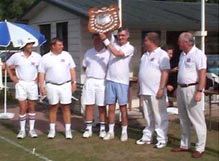 The victorious British team hold high the Shield they very nearly lost in Christchurch.
The victorious British team hold high the Shield they very nearly lost in Christchurch.
|
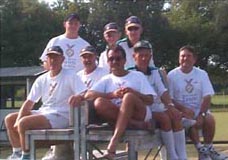 The New Zealand team who (almost) made a miracle.
The New Zealand team who (almost) made a miracle.
|
Over the last few years, New Zealand Croquet have employed a sports psychologist to work with representative squads and national teams. While there are some players who pay little heed to this style of motivation, for others it provides a basis upon which to develop skills of mental preparation for the pressured atmosphere of representative croquet. I believe that for some of our key players, this has proven to be a wise investment by the sport’s governing body.
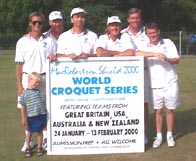
|
| The team who broke through to third place, with American captain John Taves' eldest son (the short one). |
The selection of the United Croquet Club as the venue was an important factor in the ultimate performance of the Kiwis. Traditionally, the lawns have been notoriously fast, particularly during the peak of summer in January. This has been nullified to a large extent over the past ten years with the installation of automatic watering systems. One key request from the New Zealand team was for the lawns to be as fast and testing as possible, as they believed this would give them the greatest opportunity to compete successfully against the Brits. The theory was that by ensuring very difficult conditions, the innings would change hands more often, thus nullifying much of the "ultra-aggressive" tactics currently employed by the best British players.

|
| The team with the most rookies - the Australians, who are training a promising stable of young players for future glory. |
In response to this request, the local organisers arranged for all watering of the lawns to cease, producing the rock-solid ground conditions that would provide the ultimate challenge for the world’s best players. Unfortunately, the weather decided that it would not play along; Christchurch experienced one of its wettest summers in years! But finally, towards the end of the second week, the sunshine made its mark and our notoriously dry, northwest winds turned the greens into the tricky surface we knew they could become!
New Zealand knew they needed a good start against the British. Good performances from Prince/Wislang and Garrison/Jones led to a morale-boosting first-day lead. The feeling in the New Zealand camp was that they needed only to split the singles 2-2 the next day to maintain their lead, which is in fact what happened.
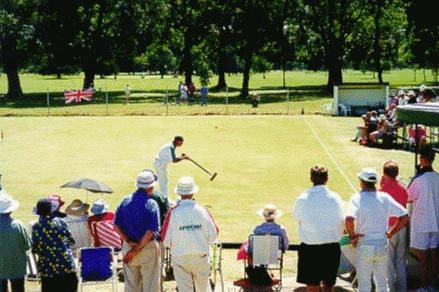
|
| As befits croquet royalty, John Prince attracted a huge crowd of adoring New Zealanders during the final test. In this match, he and Brian Wislang delivered in straight games the first-ever MacRob defeat of the dynamic British duo of Fulford and Clarke. |
As the tension mounted and the closeness of the competition became evident, the crowds continued to swell. By the last three days of the event, throngs of around 250 were showing their support for the home team. The only time I have experienced anything approaching this sort of atmosphere at the MacRobertson was in the GB vs NZ first test at Cheltenham in 1986.
The New Zealanders rose to the challenge and won some excellent results before finally falling at the last hurdle. John Prince and Brian Wislang produced a superb effort to inflict upon Fulford and Clarke their first ever MacRobertson defeat as a doubles team. Richard Baker demonstrated his ability to match it with the world’s best by defeating the current World no. 1 under the most extreme of pressure. Steve Jones made it two from two against Chris Clarke in MacRob singles by salvaging victory after being pegged out in the third game of their best of three.
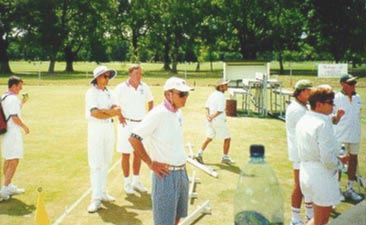
|
| American and Australian players and supporters anxiously watch the doubles match which will decide the test. Left to right: Jacques Fournier, Jeff Soo, Don Fournier, Steve Johnston, Max Donati, Martin Clarke, Pam Johnston, Peter Tavender. |
In the end, though, the cool head of David Maugham was fated to produce the goods when it mattered most. The British are to be heartily congratulated on once again proving they are the best in the world. If the next series, to be held in the United States, is even half as exciting, it will be a fantastic event.
Long live the MacRobertson!
Graham Beale lives in Christchurch, New Zealand, with his wife Christine and their two sons, Jordan (aged five) and Samuel (three) . He is an educational consultant in ICT [information and communication technology], who also lectures part time at the Christchurch College of Education.
Graham comes from a croquet-playing family and began taking croquet seriously when only 14, spending all his summer holidays either playing croquet or scouring the local library for publications on the sport.
He was runner-up to Bob Jackson in the final of the New Zealand Open Championship in 1984 (the first time he had entered this event) and gained his first representative honour when selected as a member of the successful New Zealand MacRobertson team in 1986. This was followed by successes a year later in winning the Presidentıs Invitation event, as well as producing the first sextuple to be completed in North America - playing in the World Championship at Sonoma. He has played at the Sonoma World Championship event three times and rates it "the best croquet event in the world, outside of the MacRob of course!"
Graham was selected for the 1990 MacRobertson series and again in 1993, this time as captain. In recent times he has tended to become known as a doubles "specialist" in tournament play, winning three New Zealand doubles titles partnering Richard Baker (twice) and John Prince. His most recent involvement with croquet at the highest level was in his role as facilitator/coach for the New Zealand team in their buildup to the just-completed MacRobertson series.
[Editor's notes: Thanks to Jeff Soo of the American team for the action photos and caption information. The next MacRobertson Shield will be played at the new 12-court USCA National complex in West Palm Beach, Florida, in the 2003-04 winter season.]